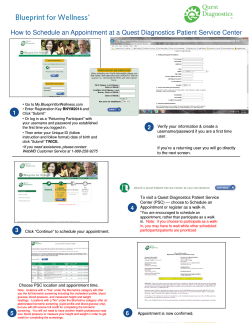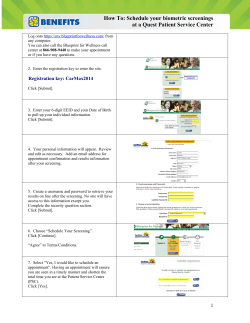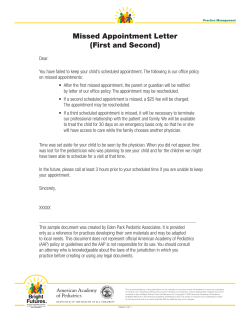
How To Create A Winning Sales Process
How To Create A Winning Sales Process Web: www.mtdsalestraining.com Telephone: 0800 CV3 8492TQ 6732 MTD Sales Training, 5 Orchard Court, Binley Business Park, Coventry, Web: www.mtdsalestraining.com Phone: 0800 849 6732 1 How To Create A Winning Sales Process The Sales Process is your guide; your step-by-step road map to sales success. To reach any goal or objective with consistency, you need a plan. The Sales Process is your plan, your blue print on how to turn a lead into a prospect, motivate a prospect to become a customer and help a customer become a long-term client. The Sales Process is like a funnel, where in you will deposit as many “raw subjects” as possible in the top of the funnel. Then, each “stage” of the sales process filters and refines these subjects, finally producing a smaller amount of sales. Professional selling is a business and a science and to be successful you must work efficiently. A properly designed sales process will help you identify obstacles and problems within your sales system. When sales are slow, it is not always due to poor closing rates. A properly designed sales process will allow you to identify the obstacles that clog your sales funnel and cost you time and money. If you design and follow a comprehensive sales process, you will move prospects systematically from “contact” to “sold” with efficiency. In this report I will help you to design your own sales process that you can customise to fit your exact selling situation and cycle… and all in just 3 easy steps. On to the first step… Step I: The Total Sales Cycle Time The first step in designing your sales process is to determine the optimum desired amount of time your sales cycle should take from beginning to end. In other words, if everything went perfect, from start to finish, how long should the sale take? How long should it be from the time you first acquired the lead or contact information, to the time you close the sale and receive the payment? Short or Long It does not matter if you work on a one-call close or a multifaceted, inter-departmental, sales cycle that takes several months. In either case, determine the optimum, best-case scenario. In addition, you need to include everything that completes the sale in this time line. If there is financing involved, then the sale is not complete until the funds are in place. Include all of the logistics; delivery, set up, installation, etc. Figure out what is the length of time the sale should take from beginning to end. Lastly, this length of time has to be a realistic figure. Do not use a figure that represents dreams and wishes. Use real life examples and case studies to make this determination. Once you have a set length of time the optimum sales process should take, then you have something to compare all sales to, as they move through the process. Web: www.mtdsalestraining.com Telephone: 0800 849 6732 2 Step II: The Sales Stages So, we’ve talked about how the sales process is your blue print to convert leads into prospects and prospects into clients – and you have now taken the first step in creating your sales process, by determining the total length of time it should take to close the sale from start to finish, under optimum conditions. With a total allotted time line set for the entire sales cycle, the next step is to figure out each stage in the sales process. You want to determine each stage of the sale and the optimum period for each stage. Consider the entire sales cycle, and then break it down into individual stages. Sample Sales Stages Below are some sample sales stages and time frames. These are generic examples of possible sales stages and periods. Depending on your situation, many of these examples may apply, or only a few. This is just to give you a better idea of how to structure your sales stages and times. Here are 12 sample sales stages from which you can determine which apply to your particular selling parameters. Stage 1 Time Suspect Indefinite I’m not particularly fond of this term, however sales people who have worked with an organized sales process before will be familiar with it. I am referring to a piece of unqualified data. It could be the name of a business or consumer, but it is not yet a qualified prospect or even a bona fide lead. Note: The reason the first three stages have a time frame of indefinite is because it could be information stored in your database that no one has yet seen. Stage 2 Time Lead Indefinite Now you have some basic information and know that the contact could possibly be a prospect. Often, your sales information will begin with “leads.” Stage 3 Time Prospect Indefinite Now you have identified the contact as a viable prospect who meets your targeting, technical and demographic qualifications. Stage 4 Time Working 5 Days Now a sales person (or you) has attempted to contact the decision maker (DM) in this account. You determined that under optimum conditions, the sales person should make contact with the DM within five days after receiving the account. Stage 5 Time Contact 5 Days The sales rep has made contact with the DM, and should set an appointment within 5 days. Web: www.mtdsalestraining.com Telephone: 0800 849 6732 3 Stage 6 Time Appointment 10 Days The sales person has set an appointment, and should consummate that meeting within ten days. Stage 7 Time Discovery Interaction 10 Days Rep met with DM and conducted the discovery meeting. interaction to take place no longer than ten days later. You want the closing Stage 8 Time Proposal/Closing Interaction 7 Days Sales person made the proposal and asked for the order. Stage 9 Negotiating Now negotiating or waiting for a decision. Time 5 Days Stage 10 Order The DM has placed an order. Time 7 Days Stage 11 Shipped The order has been shipped. Time 2 Days Stage 12 Sold Product delivered and payment received. Time 3 Days As you can see, these are very generic stages, but you get the idea. Also, there are many other stages you may need to use such as: Opt-in Literature Sent Literature Received Follow Up Call Not Interested No Sale - There is a big difference between Not interested and No Sale Disqualified Order Shipped In Financing You may also consider additional stages after the sale, such as: Customer Reorder Customer Phase II Expansion Customer Client Partner Design the stages of your sales process Web: www.mtdsalestraining.com Telephone: 0800 849 6732 4 Step III: Putting It All Together So, by now you have completed the first two steps in designing your sales process. You have determined the total length of time of the optimum sales cycle, and you have designed the individual sales stages. Now, let us look at what to do with this information and how the sales process will help you get better results from your sales activity and make more sales! Let’s use a hypothetical sales person whose sales process looks like this: Stage Suspect Lead Prospect Working Contact Appointment Interaction Proposal Negotiating Order Installation Sold Total 12 Stages Time Indefinite Indefinite 1 Day 5 Days 10 Days 10 Days 2 Days 1 Day 0 Days 1 Day 1 Day 0 Days Maximum time: 31 days For this sales person, once they have a prospect, they should be actively working the account immediately. They should make contact with the decision maker (DM) within five days after receiving the account, and they have ten days to set an appointment. That sales interaction should take place within ten days and then the prospect should have a proposal two days later. In this sample sales process, there is no negotiating or waiting time for a decision, as the sales person should get a decision during that closing interaction. If the prospect accepts the offer, the order should be in the system the next day, the installation complete the day after, and payment received on or before installation. Web: www.mtdsalestraining.com Telephone: 0800 849 6732 5 Further Aspects Of The Sales Process To Consider CRM Software And Your Sales Process Once you have established a solid sales process, you need to configure and customise your CRM (Customer Relationship Management) software program to reflect and accurately record your activity. Every account in your database should have a “stage” assigned and your system should be able to give you reports of how many accounts are at what stages and how long they have been there. The Science Of The Sales Process With this sales process in place, we look and see that our sales person is having some problems. Although they are working hard, and has a closing average that is actually a little higher than most sales people in the firm, they are consistently under sales quota. What is wrong? We investigate using the CRM software’s calculations and find that the sales person’s sales process is far off of the optimum plan: Stage Suspect Lead Prospect Working Contact Appointment Interaction Proposal Negotiating Order Installation Sold Total 12 Stages Time 0 Days 0 Days 0 Days 22 Days 2 Days 15 Days 8 Days 4 Days 0 Days 1 Day 1 Day 0 Days Actual time: 53 days You can see some major problems right away. First, the sales person does indeed work hard, as it appears the moment they get an account; they immediately go to work on it. However, when it should take them 5 days to make contact with the DM, it takes our sales person an average of 22 days, as some accounts remain in the “contact” position indefinitely! Once our sales person reaches the DM, they set the appointment almost instantly, often in one cold call. What do you think is one of the sales person’s problems? Web: www.mtdsalestraining.com Telephone: 0800 849 6732 6 Uncover The Problem And Fix It We can plainly see that our sales person is great at setting the appointment once they reach the DM, but they have a real problem getting through gatekeeper screens. You may think that this would be obvious, yet it usually is not. When you are working with dozens or hundreds of leads, and making tons of cold calls, as long has you are having some success, it is very difficult to see the facts. We can also see that the sales person usually sets the appointment too far out. In addition, after the sales interaction, the prospect should receive a proposal the next day. However, it takes our rep over a week to deliver a proposal. Why is this? Establish a solid sales process and use it to sharpen your selling activities at every stage. As you can see, our hypothetical sales person could actually have a high closing average. That is, they may close most of the proposals they finally deliver. However, until they address the problems in their process, they will never be successful. A Final Thought Lastly, in establishing your sales process, set closing averages at each stage, as well. For instance, what percentage of DMs contacted, should result in an appointment? How many appointments should result in a proposal? Let’s assume your optimum process says that 80% of all sales interactions should result in a delivered proposal. However, you see that your average is only 50%. You instantly know that you have a problem and you know exactly where and what it is, and now you can fix it. Establish a solid sales process and take the guesswork out of selling. Until next time… Happy Selling! Sean Sean McPheat Managing Director MTD Sales Training Web: www.mtdsalestraining.com Telephone: 0800 849 6732 7 About Us MTD, the sales training specialists, has been working with a wide variety of clients (both large and small) in the UK and internationally since 2001. Since that time we have delivered training in over 23 different countries to over 2,000 different organisations. Our head offices are based in the Midlands where we have our very own training centre, including a multi-media suite that enables us to provide a full range of blended learning solutions including video, podcasts, e-learning and online support solutions. We specialise in providing: In-house, tailor made sales training courses (1-5 days duration) Open courses (Delivered throughout the UK at various locations) Ongoing sales development programmes (From 5 days to 2 years) Blended learning solutions (online and offline) Sales coaching (With Sales Directors or Sales Executives) Our team of highly skilled and experienced trainers and consultants have all had distinguished careers in senior sales roles and bring with them a wealth of practical experience to each course. At MTD Training we will design and deliver a solution that suits your specific needs addressing the issues and requirements from your training brief that best fits your culture, learning style and ways of working. Our Key Unique Selling Point “Bespoke, practical and quality training delivered by a trainer experienced in your industry is a “given”. Where we really make a difference is how we help your sales peoples to embed and implement the learning after the course. We offer industry leading post course support to make this happen so you get a real, tangible return on your investment” Head Office: MTD Sales Training, 5 Orchard Court, Binley Business Park, Coventry, Warwickshire, CV3 2TQ Website: Email: Telephone: www.mtdsalestraining.com enquiries@mtdsalestraining.com 0800 849 6732 Web: www.mtdsalestraining.com Telephone: 0800 849 6732 8 MTD Have Worked With... Credibility and trust are two important factors when selecting an external training partner as you will want to know that you are in safe hands. From multi-nationals through to the small business, no matter what your industry, size or complexity is, we have delivered training to over 2000 different organisations that include: Web: www.mtdsalestraining.com Telephone: 0800 849 6732 9
© Copyright 2025









